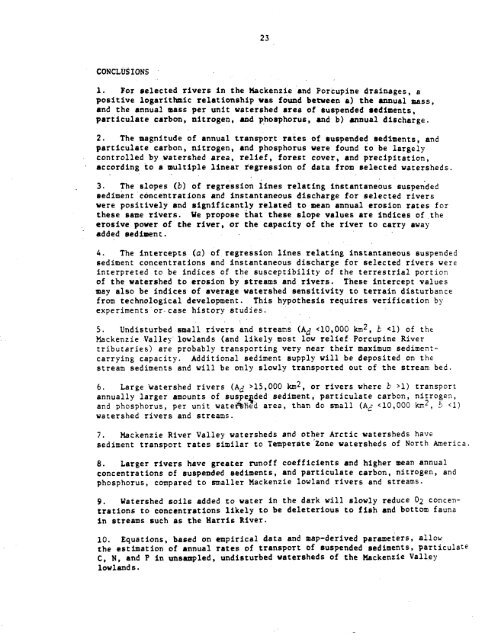The chemistry, mineralogy, and rates of transport of sediments in the ...
The chemistry, mineralogy, and rates of transport of sediments in the ...
The chemistry, mineralogy, and rates of transport of sediments in the ...
Create successful ePaper yourself
Turn your PDF publications into a flip-book with our unique Google optimized e-Paper software.
23<br />
CONCLUSIONS<br />
1 . For selected rivers <strong>in</strong> <strong>the</strong> Mackenzie <strong>and</strong> Porcup<strong>in</strong>e dra<strong>in</strong>ages, a<br />
positive logarithmic relationship was found between a) <strong>the</strong> annual mass,<br />
<strong>and</strong> <strong>the</strong> annual mass per unit watershed area <strong>of</strong> suspended <strong>sediments</strong>,<br />
particulate carbon, nitrogen, <strong>and</strong> phosphorus, <strong>and</strong> b) annual discharge .<br />
2 . <strong>The</strong> magnitude <strong>of</strong> annual <strong>transport</strong> <strong>rates</strong><br />
particulate carbon, nitrogen, <strong>and</strong> phosphorus<br />
controlled by watershed area, relief, forest<br />
accord<strong>in</strong>g to a multiple l<strong>in</strong>ear regression <strong>of</strong><br />
<strong>of</strong> suspended <strong>sediments</strong>, <strong>and</strong><br />
were found to be largely<br />
cover, <strong>and</strong> precipitation,<br />
data from selected watersheds .<br />
3 . <strong>The</strong> slopes (b) <strong>of</strong> regression l<strong>in</strong>es relat<strong>in</strong>g <strong>in</strong>stantaneous suspended<br />
sediment concentrations <strong>and</strong> <strong>in</strong>stantaneous discharge for selected rivers<br />
were positively <strong>and</strong> significantly related to mean annual erosion <strong>rates</strong> for<br />
<strong>the</strong>se same rivers . We propose that <strong>the</strong>se slope values are <strong>in</strong>dices <strong>of</strong> <strong>the</strong><br />
erosive power <strong>of</strong> <strong>the</strong> river, or <strong>the</strong> capacity <strong>of</strong> <strong>the</strong> river to carry away<br />
added sediment .<br />
4 . <strong>The</strong> <strong>in</strong>tercepts (a) <strong>of</strong> regression l<strong>in</strong>es relat<strong>in</strong>g <strong>in</strong>stantaneous suspended<br />
sediment concentrations <strong>and</strong> <strong>in</strong>stantaneous discharge for selected rivers were<br />
<strong>in</strong>terpreted to be <strong>in</strong>dices <strong>of</strong> <strong>the</strong> susceptibility <strong>of</strong> <strong>the</strong> terrestrial portion<br />
<strong>of</strong> <strong>the</strong> watershed to erosion by streams <strong>and</strong> rivers . <strong>The</strong>se <strong>in</strong>tercept values<br />
may also be <strong>in</strong>dices <strong>of</strong> average watershed sensitivity to terra<strong>in</strong> disturbance<br />
from technological development . This hypo<strong>the</strong>sis requires verification by<br />
experiments'or-case history studies .<br />
5 . Undisturbed small rivers <strong>and</strong> streams (Ad 1) <strong>transport</strong><br />
annually larger amounts <strong>of</strong> suspe ded sediment, particulate carbon, nitrogen,<br />
<strong>and</strong> phosphorus, per unit water'S}ied area, than do small (Ad
















